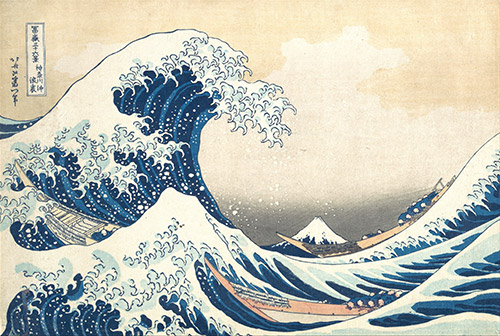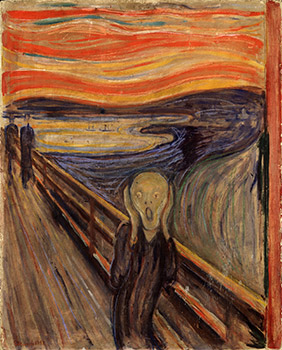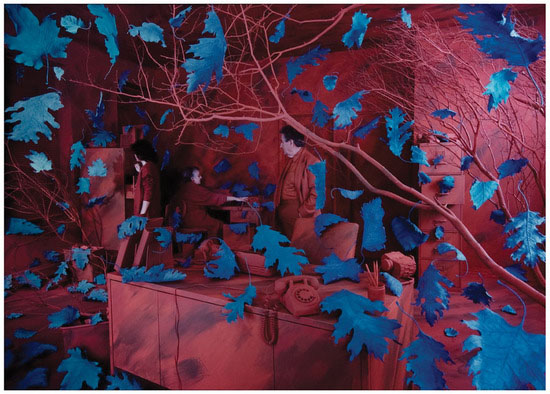Learn
Movement and Rhythm
Movement
Movement is the path the viewer's eye takes through the work of art, often to focal areas. Such movement can be directed along lines, edges, shape, and color within the work of art. Artists use movement to direct the viewer's eye through a work of art.
There are three types of movement in art:
- physical movement,
- juxtaposition, and
- moving the viewer's eye.
Physical Movement
Physical movement is the first type of movement found in an artwork. It is the obvious, physical movement. This is the feeling of action found in a work of art. This can be conveyed by drawing or painting lines coming from the object that is moving. It can be actual in a three dimensional artwork such as a mobile A mobile is a type of kinetic sculpture. It consists of a number of rods from which weighted objects or other rods hang. The objects balance on the rods. The rods and objects hang from a string or wire..
View Giacomo Balla's Dynamism of a Dog on a Leash (1912) to see an example of physical movement in a work of art.
Juxtaposition
Juxtaposition is the second type of movement. In juxtaposition, the artist portrays the subject in somewhat of a "freeze frame.” This type of movement can show the subject in the air, or at an angle.

Edgar Degas, The Rehearsal Onstage, 1874, pastel over brush-and-ink drawing. See a larger version of The Rehearsal Onstage here. Image is in the public domain.
This is an example of juxtaposition and physical movement in a work of art.
Moving the Viewer's Eye
Moving the viewer's eye is the third type of movement. It deals with the way the viewer's eye moves through the work of art. Movement is dictated by the way the objects are placed on the picture plane or by the way the artist uses the elements of art throughout the artwork.
Hokusai's Under the Wave off Kanagawa is an example of how an artist can move the viewer's eye.

Katsushika Hokusai, Under the Wave off Kanagawa or The Great Wave, 1830-1832, woodblock print, ink on paper. See a larger version of Under the Wave off Kanagawa here. Image is in the public domain.
Rhythm
Rhythm is created when one or more elements of design are used repeatedly to create a feeling of organized movement. Rhythm creates a mood like music or dancing. To keep rhythm exciting and active, variety is essential.
Rhythm can be random, regular, alternating, flowing, or progressive.
- Random Rhythm: Elements are repeated with no regularity and therefore create a random rhythm.
- Regular Rhythm: Regular rhythm is created when a series of elements (often identical or similar) are placed at regular intervals in an artwork. If an artist isn't careful, this type of rhythm can be monotonous or boring.
- Alternating Rhythm: Alternating rhythm is when two or more motifs are alternated. It is similar to regular rhythm but, because more things are repeated, it adds more variety to an artwork.
- Flowing Rhythm: Flowing rhythm is created by bending and curving different elements and intervals in an artwork.
- Progressive Rhythm: In progressive rhythm, each time an element or motif repeats itself, it changes a little and transforms gradually. It changes from one thing to another.
Artists will use varying types of rhythm within an individual work of art. Rhythm, movement, balance, and proportion, as well as emphasis and variety, are always used in a work of art to create unity.
Look at some examples of different types of rhythm below.
Edvard Munch's The Scream (1893) is an example of regular and flowing pattern rhythm.

Edvard Munch, The Scream, 1893, oil and crayon on cardboard. See a larger image of The Scream here. Image is in the public domain.
Sandy Skoglund's photograph A Breeze at Work (1987) is an example of alternating rhythm.

"Sandy Skoglund – Breeze at Work (1987)" by cea+ is licensed under CC BY 2.0.
Open Georges Braque's Candlestick and Playing Cards on a Table (1910) to see an example of progressive rhythm.
Repetition and Pattern
To create rhythm in art, artists also use repetition and pattern.
Repetition is when an object, shape, form, color, or pattern is repeated over and over again to create a rhythm. It helps unify an artwork.
Gustav Klimt's The Tree of Life, below, is an example of repetition in a work of art.

Gustav Klimt, The Tree of Life, 1909, oil on canvas. See a larger version of The Tree of Life here. Image is in the public domain.
Pattern is when a combination of elements or shapes are repeated in a predictable, recurring arrangement in a work of art. Artists use pattern to symbolically represent many things such as people, beliefs, nature, history, and tradition in their artwork.
Look at the different patterns on traditional Ghanaian kente cloth.
